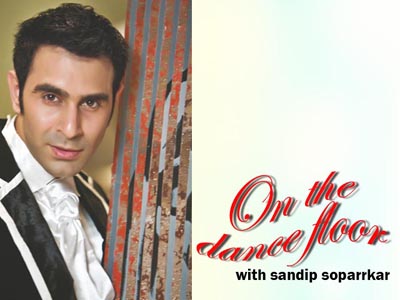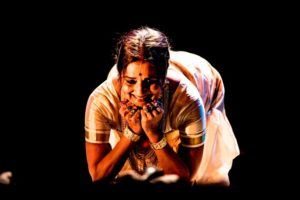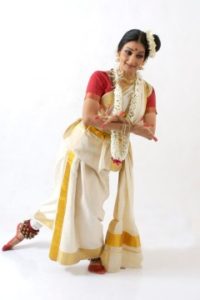Frontiers beyond the form – Mandakini Trivedi

There are some artistes who follow the art they have learnt from their gurus exactly the way they were taught or should I say exactly to the T. Then there are some who think beyond and try to achieve new horizons yet keeping the essence of their art alive. I am talking about one such incredible artiste who is not just a fantastic dancer but a true performer, choreographer, writer and a fabulous teacher – Mandakini Trivedi.
Honoured with the prestigious Sangeet Natak Akademi Puraskar (Award) in 2015 for Mohiniattam, Mandakini Trivedi is a unique dance personality whose quest for truth through art has taken her to frontiers beyond the form. She is holds Masters in Fine Art (MFA) in dance from Mumbai University’s Nalanda Nrityakala Mahavidyalaya and is trained in Mohiniattam under the expert guidance of Padma Bhushan and Padmashree Dr Kanak Rele and has also taken master classes in Mohiniattam from Smt Kalyanikuttiamma, Smt Kalamandalam Satyabhama and Smt Kalamandalam Leelamma.
All through her dance training, Mandakiniji was drawn to the undercurrents of spirituality in Indian aesthetics, she was convinced that it was not a mere coincidence, a poetic or mythological exaggeration that Bharata, the compiler of Natyashastra was a muni, that Shiva and all the gods of the pantheon danced, that the aesthetic experience was compared to the spiritual experience. Neither did she feel that this spiritual background was a matter of history irrelevant to the times. She pondered deeply on these issues wondering why the professional dance scene was so far away from its original background.
As if in answer to this deep query, she met her spiritual master, Swami Shri Harish Madhukar ‘Babaji’, a jolly fakir who was not a dancer but in him she saw the joy that the aestheticians referred to as the ultimate purpose of art. For many years, she practiced spiritual sadhanas with him, away from the world of professional dancing and understood the deep roots of mysticism and spirituality in art. She understood what ‘sadhana’ or spiritual discipline really meant! Her performances, choreographies and lecture demonstrations, all became coloured by the fragrance of the master’s teachings. Truly, she realised that there is no difference between art and spirituality. Dance is the highest yoga and art only a means to expand Consciousness. Henceforth, this understanding permeated all her work.
Mandakiniji is the recipient of the Central Government Junior Fellowship for research in Mohiniattam. She was the professor of Indian Dance at Nalanda Nrityakala Mahavidyalaya under Mumbai University for 12 years and a curator at Kala Ghoda Arts Festival for 2007 and 2008. I recently attended an intimate evening at the house of actress Mita Vasisht where Mandakiniji presented a short piece from Mahabharata. A multimedia dance theatre form, an adaptation in Hindi, of Tagore’s Karna-Kunti Samvad, incorporating multiple styles, painting and theatrical elements. Totally mesmerised by her interpretation and presentation, I sat down to talk to this graceful and soft spoken dancer who has given a total new twist to Mohiniattam…
Tell me about your ashram experience?
As the chairperson of Shaktiyogashrama, founded by Swami Shri Harish Madhukar, I conduct residential programmes at the ashram, initiating young minds into holistic lifestyles and spiritual principles that have shaped Indian art and life and given it its unique character.
What is the dance gurukul all about?
Having understood the essence of yoga from Babaji, I studied the details of the yoga shastra under Shri Sharad Pathak of Tibetan Global Research Institute to further corelate dance and yoga. I found that not only is Indian dance essentially spiritual but the very form is nothing but yoga-perfected body geometry leading one to a perfected state of being. I discovered that Indian dance is sensual, scientific and a journey to the source. I wondered why is dance not taught like this or lived like this? Why has performing become a sensual entertainment, a mere profession, a hypocritical expression of divine themes that are not lived or genuinely felt? These questions gave birth to Nateshvari Dance Gurukul, a space that addresses all these issues and grooms young dancers to look at themselves while they look at the art.
Your dance awareness programme is well-known. Please throw more light on it…
My thought-provoking lecture-demonstrations on Indian dance that are mainly aimed at reviving the roots of Indian dance in yoga have inspired young dance students to relook at the art and its practice; they have been eye-openers for students of allied disciplines such as architecture and design and made them aware of the breadth and potential of Indian dance. They have also created a love for the idiom in lay-persons. I have taken these workshops to schools, colleges, dance Schools, government as well as corporate organisations and professional colleges of allied disciplines like architecture and design and the industrial design centre, IIT Bombay and many more.
What about your writing work?
I write articles on classical Indian dance in many leading newspapers and magazines. I love to write as I feel just like dance, I can express through writing as well. Writing helps me to look at dance in a more in-depth way just the way dance does. To me, dance and writing are similar in many ways.
Some of my writing work is Master’s thesis – The Evolution of Hastas from Mudras. Ananda Yoga – Conversations on Happiness, being dialogues with Swami Shri Harish Madhukar. The Yoga of India Dance – Concealed beneath the rich and intricate fabric of classical Indian dance lays a system of mind -body discipline that is at once aesthetic, symbolic and yogic. Its themes steeped in mythology still contain wisdom relevant to our times.
Sutras on Dance – In the form of personal ruminations are meditations and reflections on performing and performing techniques that stem from the philosophy and practice of yoga. Meant to stimulate deep cogitation, they talk of the principles of watchable form and performing techniques that are hidden in nature and yoga. They also question the need to perform, its validity and dangers.
How are your performances and choreography unique from others?
Performing and choreographing is an important area of my work for I feels that performing is nothing but the practice and perfecting of the art and should be continued to the end of one’s life, irrespective of age and market forces.
Mandakini Tivedi is one artist who has performed for the biggest dance festivals in the country. Some of her notable performances include shows at the Kala Ghoda Arts Festival, NCPA, Rain Drops Festival, Krishna Gana Sabha Pongal Festival, Ghunghroo Festival, Konarak Festival, Kalidasa Samaroha, Khajuraho Festival, Pune Festival, the 50th Swami Haridas Sangeet Sammelan, Swati Sangeeta Mahotsava and Mumbai Festival among others.
She has composed many dance pieces that are very simple and easy to understand, her composition of Maricha Vadha from the Ramayana, Kalidasa’s description of Varsha Ritu, Vasanta Ritu and Kamadeva Nritya among others are notable for their vibrant and dynamic dance and mimetic expression. Her experimental pieces include a solo dance ballet, Shiva-Parvati Vivaha based on Kalidasa’s Kumarasambhava which uses subtle costume changes and the techniques of Bharatnatyam, Mohiniattam and Kathakali to delineate characters. Not just that Mandakiniji recently choreographed Dhrupad sangeet for an avant-garde film, Man Eats Rock directed by Munir Kabani and Nikhil Chopra and produced by the Hermes Foundation, Paris.
She is one person who tirelessly works and makes efforts to give richness to the Mohiniattam repertoire in all possible ways. Her forte is the creation of solo dance pieces that are innovative within the framework of the Mohiniattam tradition and she creates all the items she performs. Her work is marked by a dynamic use of space and the creation of powerful visual images conveyed with a moving simplicity that does not fail to touch even a common man. I wish a splendid artiste like Mandakiniji all the best for her work in the field of dance. Artistes like her are rare to find and should indeed be cherished by the world of dance.
Sandip Soparrkar is a World Book Record holder, a well known Ballroom dancer and a Bollywood choreographer who has been honoured with two National Excellence awards and one National Achievement Award by the Govt of India. He can be contacted on [email protected]



